Author: GABE TRAMBLE; Translation: Shenchao TechFlow
Introduction
For some people, automated market makers (AMMs) are the only aspect of decentralized exchanges (DEXs) that they are interested in. Due to factors such as low liquidity and reliance on traditional market makers, centralized exchanges often exclude these assets. Whether it’s Uniswap, Curve, Balancer, or aggregators like MetaMask and 1inch, AMMs have facilitated trillions of dollars in value transactions since their emergence a few years ago. The permissionless design of DEXs makes them an ideal platform for trading low-liquidity or long-tail assets, as anyone can create a market for new assets. Unlike traditional centralized exchanges (CEXs) that require manual integration of assets, AMMs can seamlessly deploy and trade any ERC-20 tokens as long as someone provides liquidity. This is because anyone can deposit assets and become a market maker in an AMM, without the need to be an institutional entity like in traditional finance (TradFi). Market makers increase liquidity on exchanges by providing buy and sell orders to ensure that transactions can be executed even without other users. They make money by exploiting the price difference between buy and sell prices.
However, most spot AMMs are very basic and usually only support buy and sell orders. Some spot AMMs and aggregators offer advanced features such as limit orders and deep liquidity (liquidity sufficient for trading by large entities). However, they still cannot transform their liquidity into other trading primitives.
In the product world, it is often said that a product needs 10 times improvement to replace existing products and gain significant adoption. The introduction of DEXs like Uniswap solves the liquidity problem by allowing users to create markets for any ERC-20 token at lightning speed.
- Friend.tech’s trend is receding, while Tip Coin’s momentum is rising.
- Difference in income among different Rollup operators How does Rollup generate income?
- AMM LP-driven perpetual contracts, options, and volatility trading products
DEXs like Uniswap and Curve have been battle-tested for a long enough period of time and can be used as primitives for other products.
Similar to DEX spot markets, other trading products such as perpetual futures (Perps) and options are also fiercely competitive and still dominated by CEXs in terms of trading volume. Despite CEXs’ dominance, there are still huge growth opportunities for perpetual futures, options, and other trading products through leveraging the composability of DeFi, stacking DeFi “building blocks,” or building interoperable applications.
Most on-chain perpetual futures and derivatives only have a few assets, use oracles, and are susceptible to liquidity issues. Without sufficient liquidity, derivative exchanges cannot operate and attract more users, which is known as the chicken-and-egg problem. To achieve this goal, new protocols are leveraging centralized and constant function AMM liquidity to drive new trading products (leverage, perpetual futures, and options). In short, the protocol uses AMMs like Uniswap as liquidity primitives to create new trading products.
-
Constant Function AMM: Liquidity is typically evenly distributed across the entire price range (Uniswap v2, Balancer).
-
Concentrated Liquidity AMM: Liquidity is concentrated within a price range (Uniswap v3).
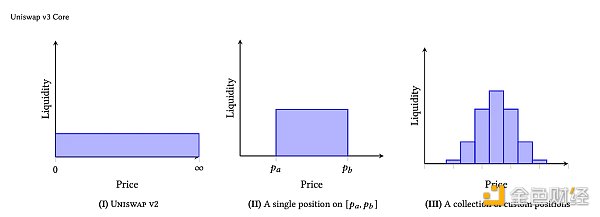
Uniswap Moment for Perpetual Futures and Options
A killer use case for AMM-driven trading products is the ability to create perpetual futures (Perps), hybrid options, and other volatility markets for illiquid and newly deployed assets. During its FOMO period, $PEPE’s market value skyrocketed to billions of dollars in just a few weeks. During this extremely volatile period, traders repeatedly asked the question, “Where can I go long on $PEPE?”
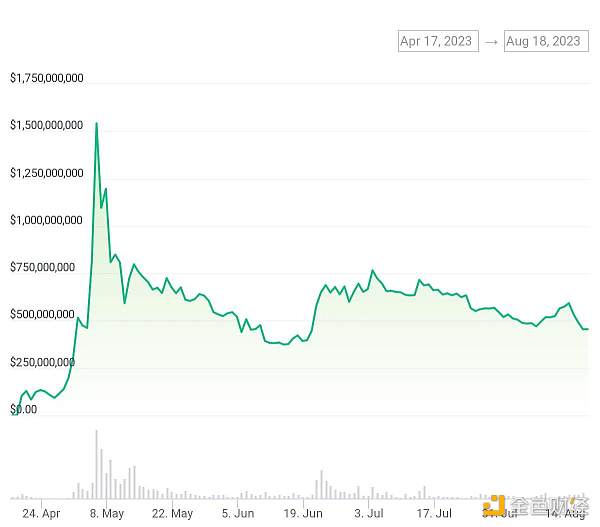
Despite PEPE’s significant popularity and attracting billions of dollars in trading volume, initially only spot markets could trade the asset. Several weeks later, some exchanges began supporting perpetual futures (Perps) trading and remained the only trading source even until now. Even in some exchanges that support $PEPE trading, many traders believe there are issues with liquidation and settlement, which is a core problem in the design of perpetual trading exchanges. Through AMM-driven volatility products and derivatives, LPs have the opportunity to marketize options and perpetual futures at token issuance, similar to Uniswap.
Cryptocurrencies have a significant speculative demand, especially in terms of leverage. In addition to leverage, these products provide good tools for hedging LPs’ positions in assets.
Perpetual Trading Products
Many on-chain perpetual contracts rely on oracles, which can be easily manipulated for long-tail assets. Oracles transform off-chain data into on-chain data usable by protocols, typically used for price feeds. Have you ever wondered why decentralized exchanges for perpetuals only support a small number of assets? Most on-chain perps and options platforms offer a limited number of assets aimed at achieving deep liquidity and utilize external oracles as pricing mechanisms. Liquidation risk is also a significant issue as managing liquidations relies on accurate oracles and ensuring trades can be liquidated in a timely manner to meet collateral requirements. In other words, liquidations need to be seamless to ensure there is enough collateral to cover the trades. Through centralized liquidity AMM (CLAMM) driven trading products, oracles and liquidation risk are often eliminated as liquidity is borrowed from a predefined LP pool.
By adopting this approach, traders’ risk is also predefined and limited within the parameters set by the exchange protocol for closing positions. Many protocols that enable AMM LPs use perpetual mechanics to determine the duration of a trade, and as long as fees are paid to keep the position open, the trade duration continues.
AMM and LP Fees
Centralized Liquidity Automated Market Makers (CLAMM) and Constant Function Automated Market Makers (CFAMM) constitute a two-sided market involving liquidity providers (LPs) and traders. For traders, the experience of AMM products is mostly similar. On the contrary, many exchanges strive to optimize the experience of providing liquidity as it often leads to losses. In many cases, LPs need additional incentives to be profitable.
Many liquidity providers add liquidity to AMMs based on the assumption that they will receive enough fees to offset impermanent losses (IL). It is also worth noting that not all LPs follow a HODL strategy. One core improvement of centralized AMM liquidity derivative models is that LPs are now compensated not only through transaction fees but also through volatility. This innovation introduces a new dimension to the rewards for providing liquidity.
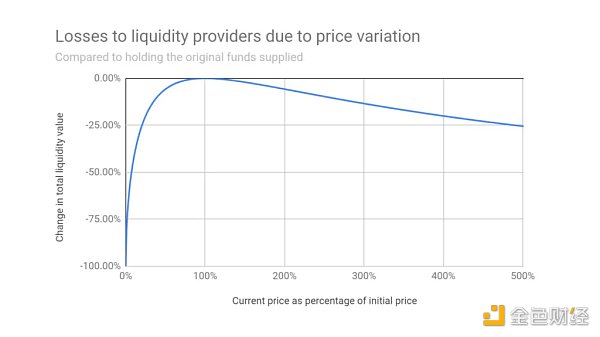
For some AMM-driven derivatives such as infinite pools and LianGuainoptic (LianGuainoptic Option Sellers), LPs can generate fees when they are within a range and commission fees when they are outside the range. When LP tokens are outside the range, they can be used for the protocol’s volatility products, whether it’s leveraged trading, margin trading, or options trading.
How do AMM LP-driven trading products work?
Currently, protocols offering AMM-driven trading derivatives follow a simple assumption that providing LP in CLAMM is similar to selling put options. In other words, the return structure for liquidity provision is mathematically similar to selling put contracts. Perpetual and volatility trading protocols can build trading derivatives and strategies around this concept, creating leverage, perpetual futures, perpetual options, and other structured products.
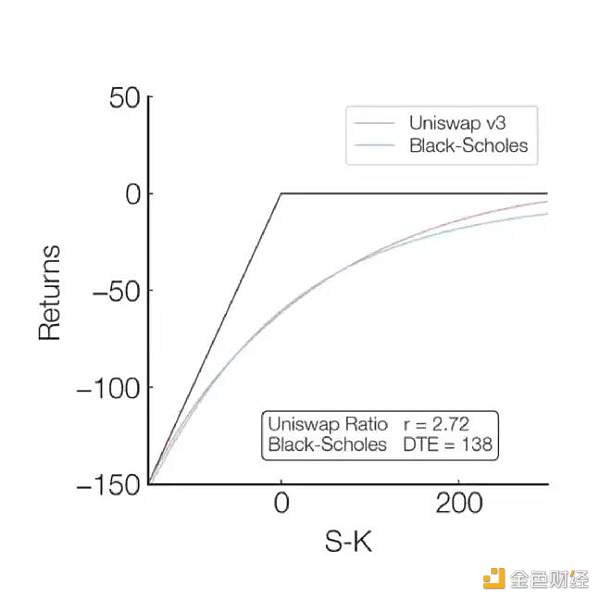
Overview of Protocols
Currently, several protocols aim to leverage CFAMM and CLAMM liquidity for trading. Some of these trading products include leverage and margin trading, options products, perpetual futures, etc. Although this concept is still novel, many developers have found opportunities to fill the liquidity and asset gap in trading products between major assets and tail assets. The table below shows the protocols, their liquidity AMMs, and the trading products created:
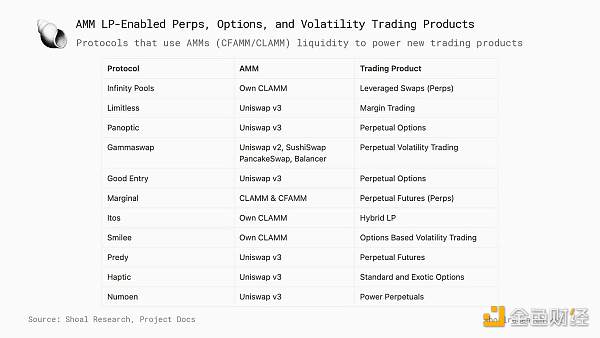
Let’s further explore the mechanisms and design.
Perpetual Options Mechanism Design
Protocols like LianGuainoptic and Smilee utilize centralized liquidity LPs to support their trading products, specifically perpetual options and volatility trading. Among the few protocols that leverage existing AMM centralized liquidity, each protocol presents slightly different architectures and implementations in constructing trading products.
At a high level, the protocols extract centralized liquidity from AMMs such as Uniswap v3 or their own AMMs and allow traders to borrow these assets. Traders then redeem the underlying LP tokens to obtain a single asset, simulating long or short positions limited to the range of centralized liquidity. Due to the nature of centralized liquidity positions, they always consist of 100% of one of the assets in a pair (e.g., USDC/ETH) when outside the range. Since LPs expect to have 100% of a pair of assets in the liquidity pool, traders need to pay fees to borrow and redeem LP tokens to obtain one of the assets. Depending on their trading strategy, they can sell the redeemed tokens and convert them into directional bets.
Using ETH Long as an Example
Using perpetual options as an example, suppose a trader wants to borrow a USDC/ETH LP token, where the price of ETH is $1000. The trader wants to go long on ETH, so they borrow the USDC/ETH LP token at a price lower than the current price, which is worth $1000 USDC. The value of the LP token is $1000 USDC because the current price has moved to the right side of the range, causing the LP (option seller) providing liquidity to hold 100% of the USDC. The exercise price for the option buyer can be considered as the midpoint of the LP range; in this example, we will use 900. Since the trader is long, they redeem the LP token worth $1000 USDC and exchange it for 1 ETH worth $1000 USDC. If the price of ETH rises to $1500, the option buyer can exercise the option by selling 1 ETH at a price of $1500, as the value of ETH now exceeds the value when the option buyer purchased it. This amount is sufficient to repay the borrower and make an additional profit of $500. The option buyer only needs to repay $1000 USDC to the LP because it is the endpoint of the liquidity range they provided.
Protocols generally abstract most of the complexity. Users may need to deposit collateral to pay for position funds, choose the duration of the position (if included), exercise price, and trading direction.
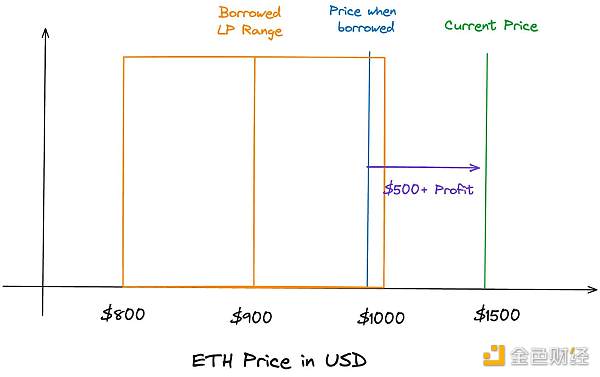
If the trade does not go as planned and the price of ETH falls to $800, beyond the opposite direction of the LP range, then the borrower now owes 1 ETH instead of USDC. Since the borrower still owes the lender 1 ETH, they need to find a way to obtain 1 ETH to repay the loan. If the value of 1 ETH is $800, the borrower needs to use $800 USDC to purchase 1 ETH to settle the debt.
Decentralized exchanges (DEXs) manage underlying assets for protocols like LianGuainoptic to ensure LPs are rewarded. Unlike prepaying a premium to buy options, LianGuainoptic requires users to have initial collateral in their wallets to pay for liquidity fees similar to funding rates. Collateral is required to ensure the payment of fees. This fee is based on the realized volatility and liquidity utilization in the underlying Uniswap pool to determine how much the option buyer should pay the seller (LP) in fees. When traders fail to pay the funding fee or the funding fee exceeds their collateral, their positions will be liquidated.
In both of these examples, the option seller continuously charges liquidity fees to maintain the position. This is a general overview related to LianGuainoptic, as each protocol has different methods for managing liquidity, providing leverage, calculating collateral, premiums, and funding fees.
From a bird’s-eye view, the trade is bilateral, with LPs depositing their LP tokens into the protocol and receiving volatility fees, and traders can open positions. LPs are incentivized to provide liquidity as they can earn rewards that outweigh other methods. A core issue for LPs in AMMs is that their fees are not sufficient to compensate for the risks. Finally, profitable traders can exercise their profitable positions or continue to pay funding rates to LPs to keep the trade open.
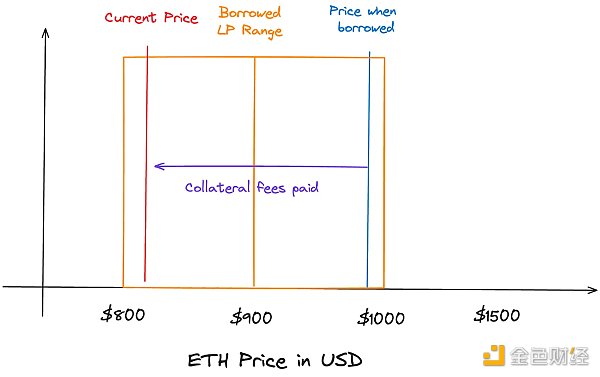
Perpetual Futures Mechanism Design
For perpetual platforms like Limitless or InfinityPools, the mechanism is similar to perpetual options. However, users can deposit collateral, which will be pooled with borrowed LPs. The required collateral and leverage are determined based on the distance to the spot price. Similar to perpetual options, if a trader borrows an LP token below a range, they can sell one of the underlying tokens to create a directional leveraged bet. The design mechanism is very similar to the previous example, with the main difference being that the deposited collateral by users is used to cover the maximum loss when the trade moves in the opposite direction. Both Limitless and InfinityPools claim to provide leverage of hundreds to thousands of times, depending on the distance between the range and the current price. If a trader incurs losses in a trade, the protocol will close their position and pay the collateral to the LP to keep the perpetual futures seller’s LP position intact.
Market Opportunities – Cryptocurrency Trading Derivatives
Traditional Financial Market Size
According to Sifma Asset Management data, the US stock market dominates globally, accounting for over 42.5% of the global stock market value of $108.6 trillion in 2023, equivalent to $44 trillion.
Traditional Financial Derivatives Market
The nominal value of the derivatives market is estimated to be over $1 quadrillion, although some believe this valuation may be inflated, according to Investopedia. This astronomical figure represents the upper limit of the nominal value of all derivative contracts.
There is a significant difference between the nominal value and the actual net value of derivatives, with these numbers being $600 trillion and $12.4 trillion respectively as of 2021.
In traditional finance, the scale of derivative trading is much larger than spot trading. The same is true for the cryptocurrency market, but most of the trading volume occurs on centralized exchanges (CEX).
Bitmex is another centralized exchange that launched their perpetual (Perp) trading tool in 2016, namely the perpetual XBTUSD leverage swap. Their new product allows users to trade Bitcoin (XBTUSD) with leverage of up to 100x. The contract has no expiration date; longs pay shorts, and vice versa. As the largest trading instrument in the cryptocurrency market, the product has expanded from centralized exchanges to various decentralized versions: DYDX, GMX, Synthetix, etc. Perpetual protocols facilitate hundreds of millions of dollars in daily trading volume and are the main derivative trading products in today’s cryptocurrency market due to their high leverage. This is a huge shift that is completely different from the dominance of options in the traditional financial derivatives market.
Cryptocurrency Spot Trading vs Perpetual Futures
In the first quarter of 2023, cryptocurrency derivatives accounted for 74.8% of the total trading volume of $2.95 trillion in the cryptocurrency market. The market share of centralized cryptocurrency exchanges (CEX) and decentralized exchanges (DEX) in spot trading was 22.8% and 2.4% respectively. It is worth noting that centralized cryptocurrency derivative exchanges like Binance, Upbit, and OKX dominate the market. According to the Coingecko 2023 Cryptocurrency Derivatives Report, while the trading volume of derivatives increased by 34.1% year-on-year, the growth rates of spot trading for CEX and DEX were 16.9% and 33.4% respectively.
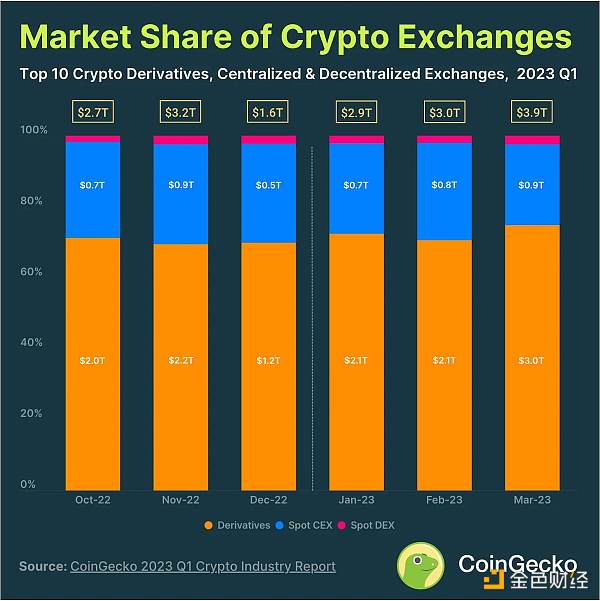
As of July 2023, 74% of cryptocurrency trading volume is conducted through leverage.
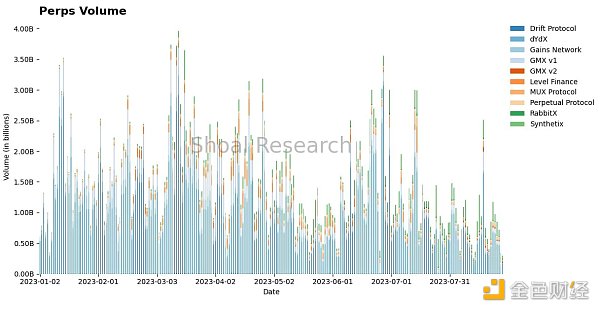
Innovative volatility trading platforms such as LianGuainoptic, Infinity Pools, Smilee, etc., have driven the industry’s development by providing high leverage, eliminating the need for oracles and clearing, and in some cases offering high leverage. With the support of centralized liquidity, AMM LP trading products eliminate some prominent weaknesses such as managing oracles and clearing.
Risks
Although these products may be exciting, risks still exist. The most significant is smart contract risk. As all AMM-LP trading products control LP tokens or require deposits, there may be smart contract risks if there are vulnerabilities or errors.
Credit liquidity risk
In addition, there are some issues with the economic design mechanisms. The Gammaswap team investigated the feasibility of developing on Uniswap v3 and CLAMMs due to concerns about “credit liquidity risk.” This risk involves liquidity providers (LPs) being unable to settle long positions or vice versa, often due to liquidation issues caused by excessive leverage. Due to centralized liquidity, automatic market makers (AMMs) like Uniswap have areas or “ticks” with lower liquidity, and prices going beyond the range may result in excessive slippage, even for stable trading pairs. Gammaswap chose to build on the constant function model, which they believe is a more powerful liquidity primitive.
In Uniswap v3, there may not be enough liquidity to meet LPs’ returns. Unlike traditional finance where the Fed can inject liquidity, there is no similar entity in the DeFi space. Additionally, the lack of oracles traditionally used for clearing adds to the complexity of this issue.
LianGuainoptic solves the issue of credit liquidity risk by requiring pool creators to deposit small amounts of two tokens throughout the range, which LianGuainoptic traders cannot remove. The initial deposit ensures that there is liquidity in all price ranges.
Complexity and user adoption
Perpetual futures (Perps) have proven to be easier for cryptocurrency investors to understand. They operate through two mechanisms: long and short positions, and traders can open positions with a simple click of a button. In contrast, options and potential perpetual options introduce additional complexity such as Greek letters, strike prices, and other traditional option knowledge, which may hinder user adoption. This is especially likely among retail investors, who are often early adopters of new trading tools. Additionally, introducing volatility trading adds to the complexity of the user experience. As the cryptocurrency space has already faced challenges with user adoption, some complex yet powerful products may struggle to gain widespread recognition due to their financial complexity.
Conclusion
Perpetual futures and options have found their place in the cryptocurrency field, and it is only a matter of time before they become mature products sought after by traders and LPs.
In the coming months, many of the mentioned protocols will launch beta versions and actual products of new trading tools. The next improvement for on-chain derivatives, including perpetual contracts and options, will be the introduction of the ability to leverage long (or short) any asset. The question of “Where can I go long on PEPE?” will be answered by providing leveraged liquidity trading channels for mid- to long-tail assets.
AMM-driven trading products pave the way for a new trading paradigm and have the potential to enable new DeFi paradigms supported by other protocols. This includes options, perpetual contracts, volatility trading, and other leveraged products. The improved trading experience will provide a more excellent experience that can even rival existing products in the market.
Like what you're reading? Subscribe to our top stories.
We will continue to update Gambling Chain; if you have any questions or suggestions, please contact us!